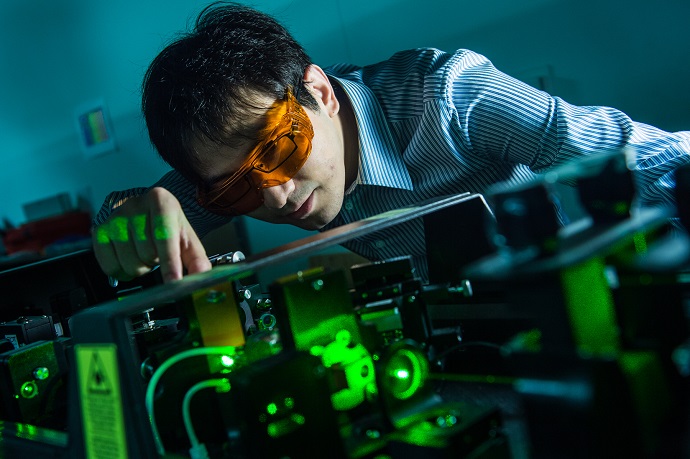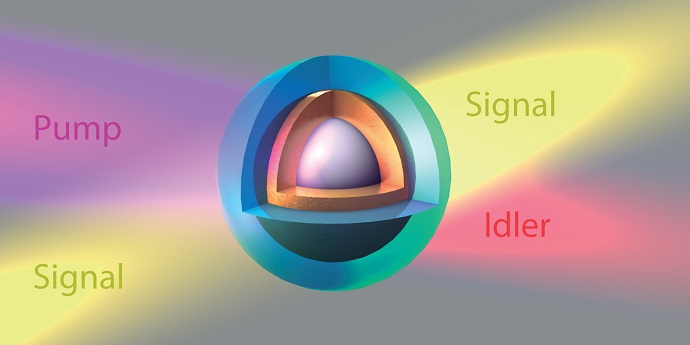HOUSTON — (May 9, 2016) — Rice University photonics researchers have unveiled a new nanoparticle amplifier that can generate infrared light and boost the output of one light by capturing and converting energy from a second light.
The innovation, the latest from Rice’s Laboratory for Nanophotonics (LANP), is described online in a paper in the American Chemical Society journal Nano Letters. The device functions much like a laser, but while lasers have a fixed output frequency, the output from Rice’s nanoscale “optical parametric amplifier” (OPA) can be tuned over a range of frequencies that includes a portion of the infrared spectrum.
“Tunable infrared OPA light sources today cost around a $100,000 and take up a good bit of space on a tabletop or lab bench,” said study lead author Yu Zhang, a former Rice graduate student at LANP. “What we’ve demonstrated, in principle, is a single nanoparticle that serves the same function and is about 400 nanometers in diameter.”

Yu Zhang (Photo by Jeff Fitlow/Rice University)
By comparison, that’s about 15 times smaller than a red blood cell, and Zhang said shrinking an infrared light source to such a small scale could open doors to new kinds of chemical sensing and molecular imaging that aren’t possible with today’s state-of-the-art nanoscale infrared spectroscopy.
Zhang, who earned his Ph.D. from Rice in 2014 and today works at Lam Research in Fremont, Calif., said parametric amplification has been used for decades in microelectronics. It involves two input signals, one weak and one strong, and two corresponding outputs. The outputs are also strong and weak, but the energy from the more powerful input — known as the “pump” — is used to amplify the weak incoming “signal” and make it the more powerful output. The low-power output — known as the “idler” — contains a residual fraction of the pump energy.
“Optical parametric amplifiers operate with light rather than electricity,” said LANP Director Naomi Halas, the lead scientist on the new study and the director of Rice’s Smalley-Curl Institute. “In OPAs, a strong pump light dramatically amplifies a weak ‘seed’ signal and generates an idler light at the same time. In our case, the pump and signal frequencies are visible, and the idler is infrared.”
While the pump laser in Rice’s device has a fixed wavelength, both the signal and idler frequencies are tunable.
“People have previously demonstrated nanoscale infrared lasers, but we believe this is the first tunable nanoscale infrared light source,” Halas said.
The breakthrough is the latest for Halas’ lab, the research arm of Rice’s Smalley-Curl Institute that specializes in the study of light-activated nanoparticles. For example, some metallic nanoparticles convert light into plasmons, waves of electrons that flow like a fluid across a particle’s surface. In dozens of studies over the past two decades, LANP researchers have explored the basic physics of plasmonics and shown that plasmonic interactions can be harnessed for applications as diverse as medical diagnostics, cancer treatment, solar-energy collection and optical computing.
One of LANP’s specialties is the design of multifunctional plasmonic nanoparticles that interact with light in more than one way. Zhang said the nanoscale OPA project required LANP’s team to create a single particle that could simultaneously resonate with three frequencies of light.
“There are intrinsic inefficiencies in the OPA process, but we were able to make up for these by designing a surface plasmon with triple resonances at the pump, signal and idler frequencies,” Zhang said. “The strategy allowed us to demonstrate tunable emission over a range of infrared frequencies — an important potential step for further development of the technology.”
Zhang said former Rice physics postdoctoral researcher Alejandro Manjavacas — now at the University of New Mexico — performed the necessary calculations to design the triple resonant nanoparticle.
Halas said the project also showcased the multidisciplinary strength of LANP. “In nanophotonics, applied and fundamental research go hand in hand because a deep understanding of the fundamental physics is what allows us to optimize particle design. That’s why one of LANP’s primary missions is to bring theoreticians and experimentalists together, and this project is a great example of how that pays off.”
Halas is Rice’s Stanley C. Moore Professor of Electrical and Computer Engineering and professor of chemistry, bioengineering, physics and astronomy, and materials science and nanoengineering. Manjavacas is assistant professor of physics and astronomy at the University of New Mexico. Additional Rice co-authors include Nathaniel Hogan, Linan Zhou, Ciceron Ayala-Orozco, Liangliang Dong, Jared Day and Peter Nordlander.
The research was supported by the Welch Foundation, the Air Force Office of Scientific Research and the University of New Mexico.















